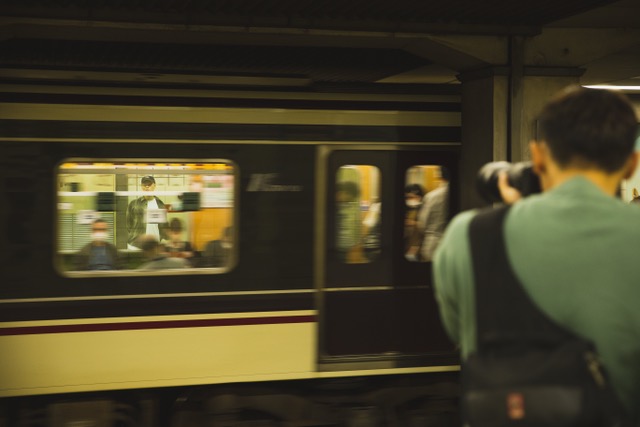Transit Agencies Should Tread Carefully When Restricting Photography

In my continuing work with transit agencies, the Ohio Transit Risk Pool (OTRP) recently asked for an opinion on the constitutionality of prohibiting and/or limiting personal photography at transit centers and on individual buses for RTAs across the Buckeye state. The bottom line is that transit agencies should not prohibit personal photography at bus terminals/stations. On a bus, any restrictions should be narrowly focused on driver/passenger safety and should not act as a blanket prohibition.
Here are the key reasons cited in my opinion:
1. First Amendment speech protections: The U.S. Supreme Court and Sixth Circuit Court of Appeals have both held that “photography qualifies as speech” meaning that First Amendment protections apply to photography. The First Amendment doesn’t just protect written or spoken words, but also mediums of expression including music, pictures, films, photographs, paintings, drawings, engravings, prints, and sculptures. However, the standard of review applied to First Amendment free speech protections depends upon the forum where the speech occurs. Which takes us to No. 2.
2. Free speech standards: A prior Sixth Circuit of Appeals decision succinctly summarized the First Amendment forum distinctions as the following:
a. A traditional public forum. This is a place “which by long tradition or by government fiat has been devoted to assembly and debate,” such as a street or park. In traditional public fora, “the rights of the state to limit expressive activity are sharply circumscribed” and the government may enforce content-based restrictions only if they are narrowly drawn to serve a compelling interest, and may enforce content-neutral time, place, and manner regulations only if they are “narrowly tailored to serve a significant government interest, and leave open ample alternative channels of communication.”
b. A limited public forum and/or a designated public forum. The government may open a limited public forum “for use by the public at large for assembly and speech, for use by certain speakers, or for the discussion of certain subjects.” Although the government need not retain the open nature of a limited public forum, “as long as it does so it is bound by the same standards as apply in a traditional public forum.”
c. A nonpublic forum. The government may control access to a nonpublic forum “based on subject matter and speaker identity so long as the distinctions drawn are reasonable in light of the purpose served by the forum and are viewpoint neutral.”
3. Free speech standards in bus stations/terminals: The U.S. Supreme Court has not squarely addressed whether a bus station/terminal constitutes a public forum. In reviewing similar cases, however, I believe a court is likely to find an individual transit terminal/station to be a public forum. For example, the Second Circuit Court of Appeals has held that a bus terminal is a traditional public forum, similar to a city street. In Wolin, the court held that “in the sense that the general public is afforded ready access to the facilities inside the Terminal, and that the Terminal was created pursuant to compact between two States and administered according to statutory requirements necessary to its function as a facility devoted to public transportation, it cannot be disputed that the Terminal is a public instrumentality.” A New Jersey district court reached the same conclusion, stating: “The terminal is a building, constructed, owned, operated and maintained by a public authority. It is open to the public, and it is in fact used by thousands of citizens each day as they travel to and
from work.” While it is possible that an individual terminal does not constitute a public forum because it does not serve non-traveling pedestrians in a commercial manner (e.g., there are no stores, shops, etc.), I recommend that individual agencies exercise caution and treat their terminals as public forums for purposes of public photography.
4. Free speech standards on buses: Conversely, a public bus system is a nonpublic forum, unintended for public discourse. In Lehman v. Shaker Heights, the court held that an Ohio municipality could prohibit political advertisements on its streetcars. Additionally, cases involving advertising commonly rule that buses are not public forums. Post-Lehman, several district courts nationwide have held that the “inside of a bus” is a nonpublic forum. In Muhammad v. Jenkins, the court held that “the MTA bus that Defendant was driving was presumptively a “nonpublic forum” under the First Amendment, and as such, the MTA could enforce reasonable restrictions on permissible speech.” And in McCall v. Intercity Transit, the U.S. District Court ruled: “Even if McCall's profanity was protected speech, Intercity Transit may enforce reasonable speech restrictions within their property.” Therefore, I believe individuals taking pictures on a bus likely falls under a nonpublic forum analysis. Given these reasons, transit agencies should exercise great caution if they intend to restrict or prohibit photography. Prohibiting personal photography in the public areas of bus terminals/stations is almost certainly unconstitutional. And if seeking to restrict photography on a bus, the rules should be narrowly focused on driver/passenger safety. Some examples of those restrictions include:
● Safety is (insert agency’s) top priority;
● Personal photography is permitted within (insert agency’s) public areas;
● Photography should not endanger or interrupt (insert agency) customers and employees.; and,
● For the safety of all parties, individuals should not use, point, or aim any camera flash toward the bus driver or in the direction of an oncoming vehicle.
Ryan Spitzer is an attorney at Isaac Wiles, where he focuses his practice on Labor and Employment and Public Law.